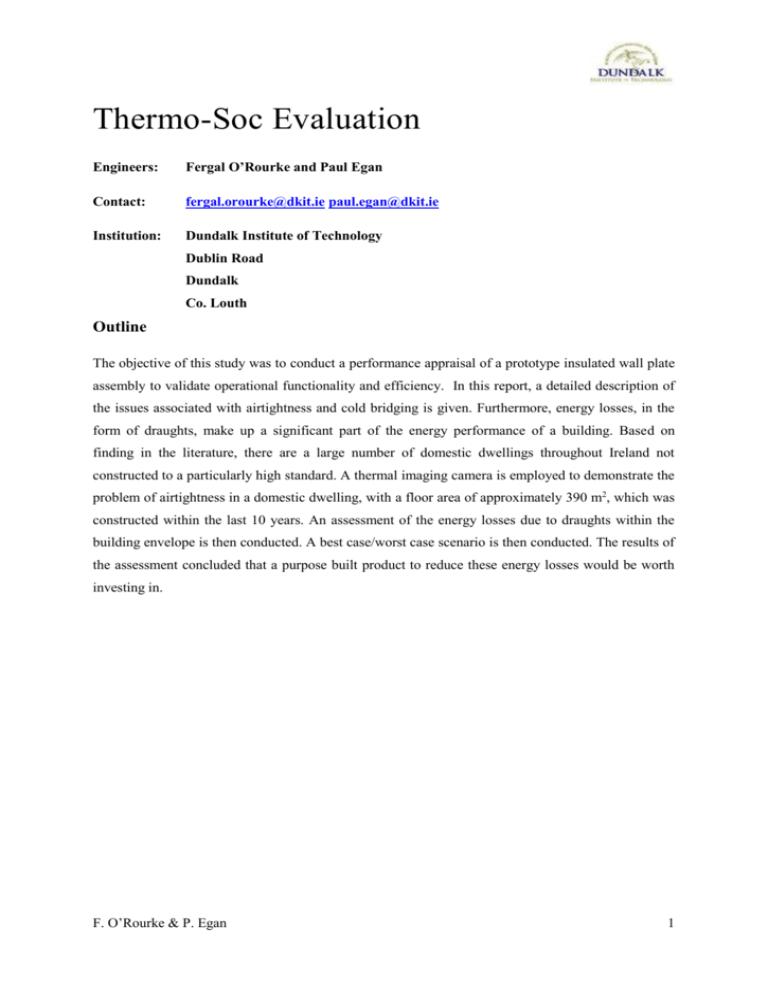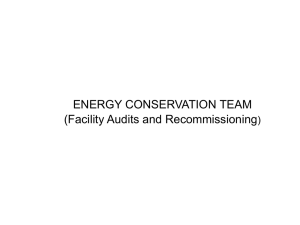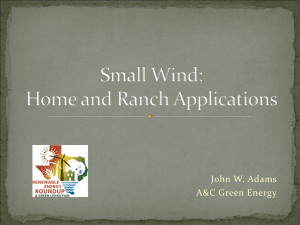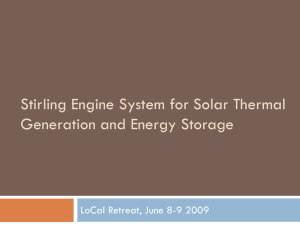Thermo-Soc Report - Greenbuilding Encyclopaedia
advertisement

Thermo-Soc Evaluation Engineers: Fergal O’Rourke and Paul Egan Contact: fergal.orourke@dkit.ie paul.egan@dkit.ie Institution: Dundalk Institute of Technology Dublin Road Dundalk Co. Louth Outline The objective of this study was to conduct a performance appraisal of a prototype insulated wall plate assembly to validate operational functionality and efficiency. In this report, a detailed description of the issues associated with airtightness and cold bridging is given. Furthermore, energy losses, in the form of draughts, make up a significant part of the energy performance of a building. Based on finding in the literature, there are a large number of domestic dwellings throughout Ireland not constructed to a particularly high standard. A thermal imaging camera is employed to demonstrate the problem of airtightness in a domestic dwelling, with a floor area of approximately 390 m2, which was constructed within the last 10 years. An assessment of the energy losses due to draughts within the building envelope is then conducted. A best case/worst case scenario is then conducted. The results of the assessment concluded that a purpose built product to reduce these energy losses would be worth investing in. F. O’Rourke & P. Egan 1 Contents 1. Introduction ..................................................................................................................................... 3 2. Motivation ....................................................................................................................................... 3 3. Problem Outline .............................................................................................................................. 4 4. 5. 6. 3.1 Introduction ............................................................................................................................. 4 3.2 Thermal Investigation of domestic dwelling........................................................................... 4 3.3 The Costs and Energy Performance ........................................................................................ 6 3.4 Estimating the Energy Performance of Poorly Insulated Wall Plate Assemblies ................. 10 Testing Procedure ......................................................................................................................... 11 4.1 Introduction ........................................................................................................................... 11 4.2 Thermo-Soc Demonstration Apparatus ................................................................................ 11 4.3 Temperature Measurements .................................................................................................. 11 4.4 Setup and environment.......................................................................................................... 12 Experimental Test Results ............................................................................................................ 12 5.1 Introduction ........................................................................................................................... 12 5.2 Smoke Test............................................................................................................................ 12 5.3 Infrared Thermography ......................................................................................................... 13 Conclusions ................................................................................................................................... 15 6.1 7. Summary ............................................................................................................................... 15 References ..................................................................................................................................... 15 List of Figures Figure 1. Thermal image of non-insulated electric wall plate assemblies .............................................. 5 Figure 2. Thermal image of uninsulated electric wall plate assemblies.................................................. 5 Figure 3. Thermo-Soc Demonstration Unit .......................................................................................... 11 Figure 4. Smoke test operating principal .............................................................................................. 12 Figure 5. 15 Minutes at 25°C ................................................................................................................ 13 Figure 6. 16 Minutes @ 25°C ............................................................................................................... 13 F. O’Rourke & P. Egan 2 Figure 7. 15 Minutes after removing heat source ................................................................................. 14 Figure 8. 1 hour @ 25°C ....................................................................................................................... 14 Figure 9. Rear of demo apparatus showing heat lost from exposed socket. ......................................... 14 Figure 10. Rear of demo apparatus showing no heat loss from insulated Thermo-Soc. ....................... 14 List of Tables Table 1. Delivered Energy Costs of a Number of Different Energy Sources (SEAI 2015) .................... 7 Table 2. Details of Heat Loss and Associated Costs for a Large Sized House (Detached) .................... 8 Table 3. Details of Heat Loss and Associated Costs for a Medium Sized House Detached) ................. 8 Table 4. Details of Heat Loss and Associated Costs for a Medium Sized House (Semi-Detached) ...... 9 Table 5. Details of Heat Loss and Associated Costs for a Small Sized House (Terraced) ..................... 9 Table 6. Details of Potential Energy Cost Saving for two different Scenarios ..................................... 10 1. Introduction The product currently under development is an insulated wall plate assembly called Thermo-Soc that seals the whole wall plate assembly and, as a result, reduces the thermal losses. The net effect of increasing the airtightness of a wall plate assembly is an increase in thermal efficiency and a reduction in space heating costs (Hassan 2013). This report firstly identifies the problem, using a thermal imaging camera in a recently built domestic dwelling. The concept and theory of operation of the device, design specification of the prototype device, results of testing, and a cost of energy (COE) analysis are described and discussed. Conclusions on the problem and the device performance are discussed. The aim of this work is to clearly identify the airtightness and cold bridging problems associated with buildings. Poor insulation and building standards has resulted in thermally inefficient buildings, resulting in high space heating costs. To reduce the inefficiencies attributed to air losses, an insulated wall plate assembly is proposed. The insulted wall plate assembly reduces the draughts which are typically experienced around regular sockets. 2. Motivation The motivation for investigating the performance of an insulated wall plate assembly for domestic and commercial applications is primarily due to the fact that a large portion of Ireland’s energy use is contributed to heating. Furthermore, poor insulation standards and cold-bridging further increases space heating costs. Over the past decade, the building standards have emphasised the importance of F. O’Rourke & P. Egan 3 insulation to reduce heat losses, and thus, increasing the thermal efficiency of domestic dwellings (Sinnott and Dyer 2012). The building standards, currently accepted, relate to the average performance of building elements. It is expected that as the standards evolve in the coming years, with the cost of energy and climate change, the significance of local areas of reduced insulation, for example: joints, gaps around windows and gaps in the building envelope, etc., all of which leading to heat losses, will become extremely important to the overall heating costs. It is estimated that the typical heating loss due to easily avoidable air leakage is between 5% and 10%. However, air losses generally account for a significant portion of the energy losses of a domestic dwelling (Alfano et al. 2012). The effects of thermal bridging and air leakage can encourage mould growth due to surface condensation and the discomfort of draughts and cold rooms. Importantly, to reduce these impacts, a more robust and consistent insulation procedure is required. Moreover, building airtightness needs significant attention at all stages of design construction and also throughout the maintenance of the building (Pan 2010). 3. Problem Outline 3.1 Introduction In this section, the problem of airtightness and cold bridging are described and discussed. Firstly, the importance of energetic performance of a build is outlined. Thermal images of a domestic dwelling are then discussed, clearly showing the problems associated with airtightness in buildings and in this case a modern building. A description of the current accepted method of assessing the energy performance of buildings in Ireland is then described and an assessment is then conducted for four separate cases and different delivered energy costs. 3.2 Thermal Investigation of domestic dwelling As discussed in Chapter 2, the airtightness of a building is critical to its energetic performance and also, the issues associated with inconsistent insulation installation. Considering these points, an investigation into the energetic performance of a modern dwelling has been conducted. The investigation involves the use of a thermal imaging camera to identify areas of air leaks, and the scale of the leaks, within the building. Figure 1 shows the scale of the air losses due to inconsistent insulation and possible gaps in the building envelope. It is important to note the scale of the temperature difference, which drives heat transfer, between the wall at 23°C and around the wall plate F. O’Rourke & P. Egan 4 assembly which is at 16°C. Furthermore, Figure 1 (right) shows, alarmingly, the conduit track up the wall where the insulation was cut to allow for electric cables. Figure 1. Thermal image of non-insulated electric wall plate assemblies There are a large number of papers in the literature focusing on the issues associated with airtightness and cold bridging. The concepts of passive house design and low energy buildings are some of the ways in which higher energy efficiencies, particularly in adverse weather conditions, can be achieved. Further to this, airtightness is considered paramount in achieving a high thermal efficiency design. Figure 2 shows additional images, using a thermal imaging camera, of other randomly selected electric wall plate assemblies. Figure 2. Thermal image of uninsulated electric wall plate assemblies F. O’Rourke & P. Egan 5 3.3 The Costs and Energy Performance There are numerous resources available to calculate the energetic performance of a building. Moreover, the “Dwelling Energy Assessment Procedure (DEAP)”, Ireland’s currently accepted method for calculating the Building Energy Rating (BER) of new and existing dwellings, assesses the compliance of building to building regulations. The DEAP software package draws upon the UK Standard Procedure (SAP) but is modified to account for Ireland’s climate conditions (NSAI 2008). Among other things DEAP incorporates an algorithm to calculate the air changes experienced under given conditions, such as floor area, the number of floors, etc. One of the key outputs of DEAP is the energy losses of the building in kWh. To further understand the significance of the energy losses, it is sometimes best to take costs into account, i.e. the energy, in terms of heat, has a cost in €/kWh. Table 1 gives details of the approximate delivered energy costs, per kWh, of a number of different energy sources. It is important to note that the majority of the delivered energy costs are similar with only the electricity (heat pump) at night rate significantly less. Furthermore, this value will give a good base line, best case/worst case, for comparison purposes. F. O’Rourke & P. Egan 6 Delivered Energy Cost [€/kWh] Oil Natural Gas 0.0747 [€/kWh] Kerosene 0.0755 [€/kWh] Natural Gas Band 1 0.0760 [€/kWh] Band 2 0.0681 [€/kWh] Band 3 0.0642 [€/kWh] Coal Lignite 0.0687 [€/kWh] Premium Coal 0.0531 [€/kWh] Standard Coal 0.0531 [€/kWh] Electricity (Heat Pump) Band DD 0.0693 [€/kWh] Band DE 0.0602 [€/kWh] Night Rate 0.0324 [€/kWh] Table 1. Delivered Energy Costs of a Number of Different Energy Sources (SEAI 2015) To further quantify the losses experienced a building, it is best to set up a number of case studies. Table 2 - Table 5 give details of different parameters of a building and using these parameters, the energy costs due to heat loss, and in particular, airtightness are calculated. The building size is varied by floor area, number of rooms, the roof size, window type, etc. A number of the building parameters are kept constant to insure continuity throughout the calculations. For all calculations a number of assumptions are made, based primarily on the literature, these include: standard double glazed windows, moderate air loss through the building envelope, an algorithm to assess each building if the best insulation and airtightness measures are put in place, delivered energy costs, etc. F. O’Rourke & P. Egan 7 Example 1 – Large Sized House (Large Detached) Typical Parameters House Floor Area [m2] 390 Outside Temperature [°C] 10 Inside Temperature [°C] 21 Insulations Thickness [m] 0.2 Windows [Type] Standard Double Glazing Air Loss [Type] Moderate Total Heat Loss [kWh] 116,159 Heat Loss Due to Draughts [%] 35 Heat Loss Due to Draughts [kWh] 40,587 Cost of Heat Loss Due to Draughts €1,315 - €3,031 Typical Parameters (Upgraded Insulation, etc.) Total Heat Loss [kWh] 43,547 Heat Loss Due to Draughts [%] 46 Heat Loss Due to Draughts [kWh] 20,293 Cost of Heat Loss Due to Draughts €657 - €1,532 Table 2. Details of Heat Loss and Associated Costs for a Large Sized House (Detached) Example 2 – Medium Sized House (Medium Detached) Typical Parameters House Floor Area [m2] 200 Outside Temperature [°C] 10 Inside Temperature [°C] 21 Insulations Thickness [m] 0.2 Windows [Type] Standard Double Glazing Air Loss [Type] Moderate Total Heat Loss [kWh] 62,291 Heat Loss Due to Draughts [%] 28 Heat Loss Due to Draughts [kWh] 17,730 Cost of Heat Loss Due to Draughts €574 - €1,339 Typical Parameters (Upgraded Insulation, etc.) Total Heat Loss [kWh] 22,155 Heat Loss Due to Draughts [%] 40 Heat Loss Due to Draughts [kWh] 8,865 Cost of Heat Loss Due to Draughts €287 - €669 Table 3. Details of Heat Loss and Associated Costs for a Medium Sized House Detached) F. O’Rourke & P. Egan 8 Example 3 – Medium Sized House (Medium Semi-Detached) Typical Parameters House Floor Area [m2] 140 Outside Temperature [°C] 10 Inside Temperature [°C] 21 Insulations Thickness [m] 0.2 Windows [Type] Standard Double Glazing Air Loss [Type] Moderate Total Heat Loss [kWh] 40,962 Heat Loss Due to Draughts [%] 30 Heat Loss Due to Draughts [kWh] 12,411 Cost of Heat Loss Due to Draughts €402 - €937 Typical Parameters (Upgraded Insulation, etc.) Total Heat Loss [kWh] 14,888 Heat Loss Due to Draughts [%] 42 Heat Loss Due to Draughts [kWh] 6,206 Cost of Heat Loss Due to Draughts €201 - €468 Table 4. Details of Heat Loss and Associated Costs for a Medium Sized House (Semi-Detached) Example 4 – Small Sized House (Terraced) Typical Parameters House Floor Area [m2] 90 Outside Temperature [°C] 10 Inside Temperature [°C] 21 Insulations Thickness [m] 0.2 Windows [Type] Standard Double Glazing Air Loss [Type] Moderate Total Heat Loss [kWh] 21,221 Heat Loss Due to Draughts [%] 33 Heat Loss Due to Draughts [kWh] 6,938 Cost of Heat Loss Due to Draughts €225 - €524 Typical Parameters (Upgraded Insulation, etc.) Total Heat Loss [kWh] 8,093 Heat Loss Due to Draughts [%] 43 Heat Loss Due to Draughts [kWh] 3,469 Cost of Heat Loss Due to Draughts €112 - €261 Table 5. Details of Heat Loss and Associated Costs for a Small Sized House (Terraced) F. O’Rourke & P. Egan 9 3.4 Estimating the Energy Performance of Poorly Insulated Wall Plate Assemblies To estimate the energy performance of non-insulated wall plate assemblies the percentage of the total air losses through electric wall plate assemblies is estimated for a number of different scenarios. Research conducted by Kalamees, 2006, considered electric sockets as a major area of concern with regard to air leakage in particular (Kalamees 2007). Further to this study, an assessment is conducted, based on an estimation of the percentage of air leakage through wall plate assemblies. Using the estimated air leakage values, an assessment of the potential energy cost savings is then conducted. If it is assumed that the best case scenario being 5% of the total air losses are experienced through the wall plate assemblies and the worst case scenario being 20% of the total air losses through the wall plate assemblies, the potential energy savings can be calculated. Table 6 gives details of the estimated energy losses through wall plate assemblies. It is clear from Table 6 that the energy loss through wall plate assemblies is an issue for all house sizes. Energy Performance Example 1 Example 2 Example 3 Example 4 House Floor Area [m2] 390 200 140 90 Outside Temperature [°C] 10 10 10 10 Inside Temperature [°C] 21 21 21 21 Air Loss [Type] Moderate Moderate Moderate Moderate Total Heat Loss [kWh] 116,159 62,291 40,962 21,221 Heat Loss Due to Draughts [%] 35 40 30 33 Heat Loss Due to Draughts [kWh] 40,587 17,730 12,411 6,938 Cost of Heat Loss Due to Draughts €1,315 - €3,031 €574 - €1,339 €402 - €937 €225 - €524 Heat Loss [kWh] 2,029 887 621 347 Cost of Heat Loss €66 - €153 €29 - €67 €20 - €47 €11 - €27 Heat Loss [kWh] 9,174 3,546 2,482 1,388 Cost of Heat Loss €693 - €297 €267 - €115 €187 - €80 €105 - €45 Parameters Through Wall Plate Assembly Best Case - 5% of Draughts Worst Case - 20% of Draughts Table 6. Details of Potential Energy Cost Saving for two different Scenarios There are a number of ways in which the air loss through wall plate assemblies can be reduced, one of these ways is to only install the wall plate assembly on interior partition walls, and not on the exterior wall. However, in the next Chapter, a method to reduce the energy loss through a wall plate assembly is proposed. The method employs an insulated and airtight assembly which is expected to significantly reduce the energy losses, and thus, the costs. F. O’Rourke & P. Egan 10 4. Testing Procedure 4.1 Introduction In this section a detailed description of the testing procedure of a device which is proposed to assist with the reduction of draughts, and consequently, energy losses is given. 4.2 Thermo-Soc Demonstration Apparatus The apparatus shown in Figure 3 was designed to demonstrate the application of the Thermo-Soc. It is comprised of a typical internal insulated wall section with two double sockets. The socket on the right (as viewed from the front) is mounted using the typical approach, where the plasterboard and insulation is cut leaving an area susceptible to thermal bridging and air leaks. Whereas the socket on the left is mounted with the insulated Thermo-Soc unit. Figure 3. Thermo-Soc Demonstration Unit 4.3 Temperature Measurements In this section the instruments and processes used to test the Thermo-Soc demonstration apparatus are discussed. Internal and external air temperature was measured using a fluke 52 K/J thermometer. This is a dual input temperature logger that can accept two thermocouples simultaneously. The device also has recording functionality and a temperature difference function. Thermal imaging was conducted using an Flir i7 infrared camera. The Flir i7 features a 120 x 120 resolution, 2% accuracy and 0.1°C sensitivity. F. O’Rourke & P. Egan 11 4.4 Setup and environment The demonstration apparatus was sealed between a temperature controlled environment at the front, while leaving the rear exposed to open air to simulate typical temperature and pressure differences between the inside and outside of a temperature controlled building. External air temperatures were a moderate 10°C - 13°C during testing and moderate to strong gusts were evident. 5. Experimental Test Results 5.1 Introduction Testing was carried out under various conditions to determine the prototype performance and the overall efficiency of the device. The results are presented in this section. 5.2 Smoke Test A smoke test was conducted to determine the level of exposure to each socket. This is an observational test that can give a good indication of air leakage around the sockets. The test involves sealing the interior space from air leaks and introducing smoke to the front of the unit. The level of disruption in the direction of the smoke indicates the level of air leakage. The operating principal of the smoke test is shown in Figure 4. Figure 4. Smoke test operating principal F. O’Rourke & P. Egan 12 During this test, results similar to those depicted in the figure were observed. The insulated ThermoSoc showed very little upset in smoke direction indicating little or no leaks whereas the conventional socket showed clear disruption indicating that air leaks were present. 5.3 Infrared Thermography Infrared imaging was conducted under a number of test conditions to show the heat loss around both sockets on the demonstration unit simultaneously. The results of these tests are shown below. Initially the controlled environment was brought to a temperature of approx. 25°C and outside temperature was measured at 13°C, creating a temperature difference of 12°C. After 15 minutes, Figure 5 and Figure 6 show that there is a clear temperature difference between the two sockets. Figure 5. 15 Minutes at 25°C F. O’Rourke & P. Egan Figure 6. 16 Minutes @ 25°C 13 Figure 7. 15 Minutes after removing Figure 8. 1 hour @ 25°C heat source Figure 9. Rear of demo apparatus Figure 10. Rear of demo apparatus showing heat lost from exposed socket. showing no heat loss from insulated Thermo-Soc. Figure 7 shows the how the wall decreases in temperature once the heat source is removed. It can be seen that the area around the standard socket cools more rapidly when compared to the Thermo-Soc. Figure 8 shows the temperatures after a period of 1 hour at 25°C. The cold spot around the standard socket is clearly causing a cooling effect on the walls surrounding it. In comparison, the Thermo-Soc is insulating very well. Figure 9 and Figure 10 show the heat loss through the rear of the device. Once again it is clear that the Thermo-Soc is considerably outperforming the conventional method at retaining heat. F. O’Rourke & P. Egan 14 6. Conclusions 6.1 Summary In this report, a detailed description of the issues associated with airtightness and cold bridging is given. Furthermore, energy losses, in the form of draughts, make up a significant part of the energy performance of a building. However, there is a lack of research in this area, which is concerning, for example, the energy performance of buildings, in general, is still nowhere near a high quality. Based on finding in the literature, there are a large number of domestic dwellings throughout Ireland not constructed to a particularly high standard. Moreover, this includes domestic dwellings constructed within the last decade. The report commences with an outline of the motivation behind the development of the Thermo-Soc. A thermal imaging camera is employed to demonstrate the problem of airtightness in a domestic dwelling, with a floor area of approximately 390 m2, which was constructed within the last 10 years. A number of thermal images were taken of electric wall plate assemblies throughout the building. This building has an insulated cavity (high density board 100 mm) and internal insulated plasterboard (30 mm). It can clearly be seen that there are significant energy losses through the electric wall plate assemblies. An assessment of the energy losses due to draughts within the building envelope was then conducted. These energy losses are significant in most cases. A best case/worst case scenario was then conducted. The results of the assessment concluded that a purpose built product to reduce these energy losses would be worth investing in. The Thermo-Soc demonstration apparatus was tested to verify functionality and operation. The testing procedure was outlined, describing the approach taken. A smoke test was conducted and observations were discussed. A thermal comparison was then conducted by varying the controlled environmental conditions for the Thermo-Soc and the non-insulated equivalent. The tests of the Thermo-Soc showed significant thermal performance improvement over conventional methods of installation. 7. References Alfano, F. R. d. A., Dell’Isola, M., Ficco, G. and Tassini, F. (2012) 'Experimental analysis of air tightness in Mediterranean buildings using the fan pressurization method', Building and Environment, 53(0), 16-25. Hassan, O. A. B. (2013) 'An alternative method for evaluating the air tightness of building components', Building and Environment, 67(0), 82-86. F. O’Rourke & P. Egan 15 Kalamees, T. (2007) 'Air tightness and air leakages of new lightweight single-family detached houses in Estonia', Building and Environment, 42(6), 2369-2377. NSAI (2008) Energy Performance of Building - Calculation of Energy Use for Space Heating and Cooling (I.S. EN ISO 13790:2008). National Standards Authority of Ireland. Pan, W. (2010) 'Relationships between air-tightness and its influencing factors of post-2006 newbuild dwellings in the UK', Building and Environment, 45(11), 2387-2399. SEAI (2015) Domestic Fuels Comparison of Energy Costs [online], available: [accessed Sinnott, D. and Dyer, M. (2012) 'Air-tightness field data for dwellings in Ireland', Building and Environment, 51(0), 269-275. F. O’Rourke & P. Egan 16






